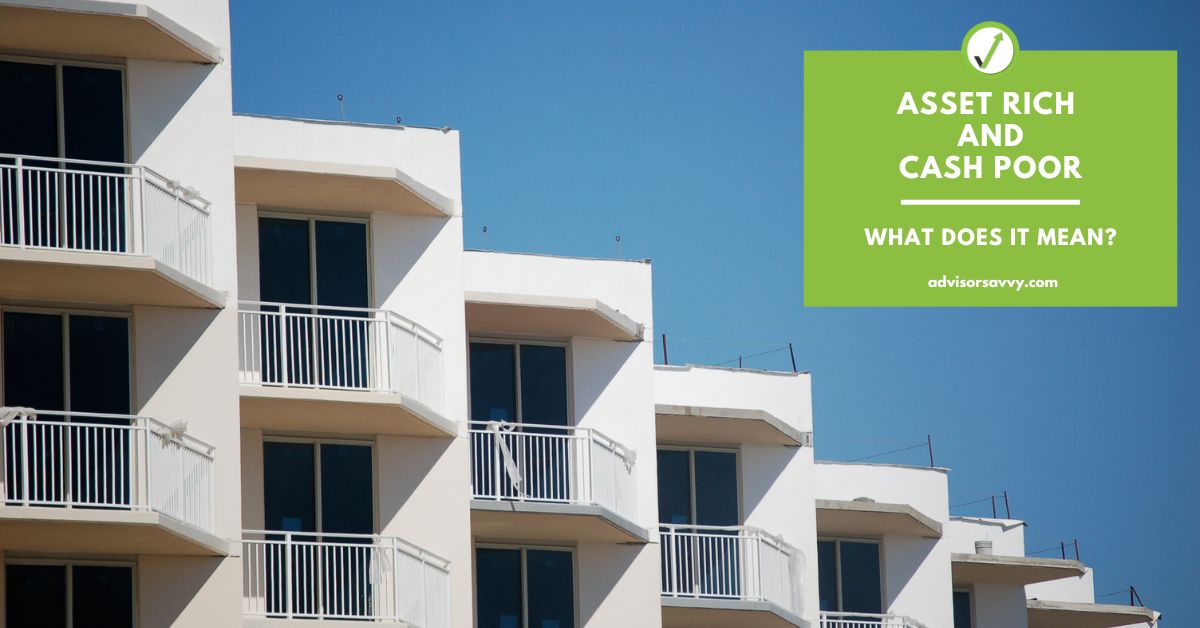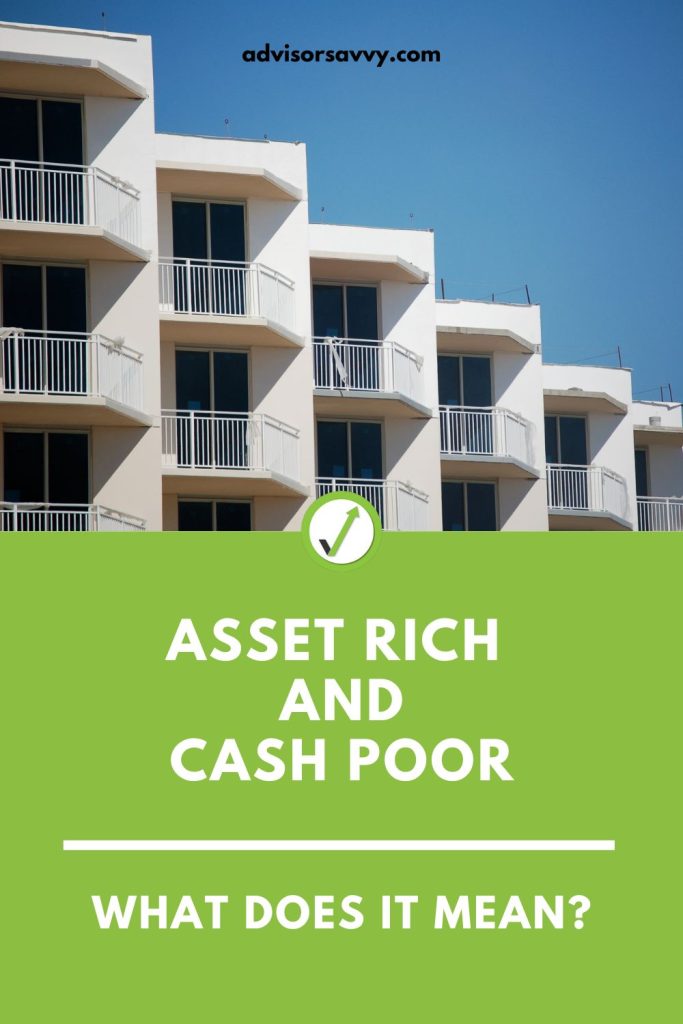
You may have heard the term “asset rich and cash poor” at one point or another. In simple words, it’s the financial position where one owns a lot of assets, but has little cash at their disposal. You might be wondering why this is a problem. After all, doesn’t everyone want to own lots of assets? In theory, yes, but cash reserves shouldn’t be neglected during the process of acquiring assets.

Table of contents
Cash allows us to pay for our daily expenses, like food, shelter and clothing. It is also an invaluable tool in times of crisis, such as an unexpected home repair or getting out of a tricky situation while traveling. If your cash is locked up in assets, it can be challenging to meet these immediate needs. In this article, we’ll explore the meaning of asset rich, cash poor in depth and how to overcome it. Continue reading to learn more!
What does “asset rich and cash poor” mean?
Asset rich and cash poor is a term you may hear in the investment world. But what does it mean? It simply means your wealth is held within assets, such as real estate or stock portfolios, that are challenging to convert into cash quickly. In addition, some assets, particularly real estate, are costly to maintain. For this reason, all cash inflows may be put towards the asset’s maintenance. Again, this results in the asset rich and cash poor phenomenon.
Ideally, Canadians should have a balanced portfolio from all standpoints. This includes having a balance of long term investments and cash reserves. For instance, Canadians should develop an emergency fund before pouring all their cash into asset purchases. Let’s take a closer look at what cash poor and asset rich means below.
Related Reading: How Many Millionaires Are There in Canada?
What is considered cash poor?
Cash poor means you have few liquid assets at your disposal. Liquidity is a term used to describe how quickly an asset can be converted into cash. The most liquid asset is, of course, cold hard cash. However, there are also highly liquid cash equivalents, such as guaranteed investment certificates, certificates of deposit, treasury bills, or bonds which are maturing in the short term (less than a year). Essentially, the easier an asset is able to convert into cash, the more liquid it is. Someone who only possesses illiquid assets would be considered cash poor.
What is considered asset rich?
On the other hand, asset rich refers to a person who owns many assets, such as cars, real estate, and investment portfolios. In most cases, these assets are not liquid. Someone who is asset rich would definitely be considered wealthy. Although, financial issues can arise if you do not have enough cash to facilitate asset ownership or cover other expenditures. For this reason, being asset rich is not necessarily ideal.
What is the difference between cash rich and asset rich?
Cash rich and asset rich are not the same thing. The only similarity cash and assets share is they are tools that can be used to produce wealth. However, a person can be rich in one resource, but not another.
Cash is the wealth you have available to spend right now. Whereas assets are what you own to create and build wealth. Therefore, being cash rich means you have a lot of financial resources to spend, but not necessarily assets under your ownership. On the contrary, being asset rich means you have a lot of wealth, but not necessarily resources to spend now.
Related Reading: Average Canadian Net Worth
Is it better to be asset rich?
As mentioned, both cash and assets are financial tools. Both are necessary investments to produce and maintain wealth. For this reason, it is not advisable to only focus on one, but not the other. In fact, this precise mentality is what causes imbalances like being asset rich and cash poor! Rather, you should aim to have a balanced portfolio of both assets and cash.
With that in mind, assets have slightly higher importance than cash. This is because assets are what allow Canadians to produce wealth and achieve financial independence, like buying a house or investing in a RRSP. However, when you overdo it, you risk becoming asset rich and cash poor. The idea is to utilize cash to invest in assets without depleting your cash resources entirely. After all, cash is necessary to pay bills and maintain your daily lifestyle.
Let’s take a look at the pros and cons of assets and cash below:
| Cash Pros | Cash Cons |
| Can be used for day to day expenses and emergencies | Return on investment is low or non-existent |
| Helps to maintain asset ownership, such as advisor fees, property taxes, repairs, and so on | Cash rarely outpaces rates of inflation |
| Asset Pros | Asset Cons |
| Establishes and grows wealth | Can be expensive and time consuming to maintain |
| Ownership can help you achieve financial freedom | The owner is exposed to more risk, there is a chance an asset may not be profitable |
Is being asset rich and cash poor common in Canada?
With the high cost of a home in Canada, being asset rich and cash poor is not uncommon. Sometimes Canadians might call this phenomenon “house-rich, cash poor”.
Real estate always involves a great deal of investment up front, particularly the down payment. In addition, the first few years of home ownership can be expensive. For instance, there may be necessary repairs and renovations that weren’t considered at the time of purchase. Alternatively, home owners may have to adjust their budget and cash flow after acquiring an asset. Between property taxes, mortgage payments, and other homeownership costs, it’s a big change for Canadians which primarily affects cash. While net worth might increase after a home purchase, managing cash definitely becomes a challenge — notably in this economic climate.
Buying real estate is the best way to establish and build wealth in North America. For this reason, many Canadians enter the housing market in an attempt to create wealth, despite the risk of becoming asset rich and cash poor. Although, many Canadians are able to stabilize their finances after undergoing the learning curve – being asset rich and cash poor is not forever!
Related Reading: Best Cash Back Credit Cards in Canada
Asset Rich, Cash Poor Solutions
To solve the asset rich and cash poor problem, focus on enhancing and optimizing your cash inflow. From there, set cash aside to build a healthy reserve. Here’s some strategies to help you do so:
- Line of credit. With low interest rates and flexible borrowing terms, a line of credit can help make ends meet while you improve your cash reserves. Home equity lines of credit are an option if you own real estate with positive equity.
- Capitalizing on assets. If you can monetize your assets, that’s a good solution to boost your cash. You can maybe rent out your car on apps like Turo and Roam. Or, consider renting a property you own to a tenant or listing it on Airbnb.
- Revisit your budget. It’s possible you’re overspending in certain areas when you shouldn’t be. Consider revisiting your budget and find areas to cut down on expenditures. Put the excess cash towards your reserve.
- Increase income. Ask for a raise at your job or pick up a side hustle to increase your cash inflows.
- Downsizing. Assets produce wealth, so this option should be a last resort. Selling assets can be expensive and time consuming, so it’s best to avoid it if you can. But if you are struggling with your cash flow after trying all the above options, you may need to liquidate your assets and downsize.
Related Reading: How Many Billionaires Are There in Canada?
Cash Flow Pattern of an Asset: Rich Dad, Poor Dad
Another asset rich and cash poor solution is from Robert Kiyosaki, the mastermind behind the 1997 book, Rich Dad Poor Dad. Robert Kiyosaki suggests three cash flow patterns of an asset. These are important to consider because they impact the asset rich and cash poor dilemma. Let’s take a closer look below:
- Poor Cash Flow. The emphasis is on making money to cover expenses, but there is no cash available to invest in assets. Or, perhaps there is less of a priority placed on buying assets. In this scenario, people often make enough to cover their expenses, but are living pay cheque to pay cheque. However, building wealth is impossible because no assets are acquired.
- Middle Class Cash Flow. Under this option, the emphasis is on earning money to invest in assets. This option is the most commonly used out of all three and is wise in many ways. Normally, the main assets purchased are cars, recreational vehicles, and homes. Although, much of the cash flows towards the debt associated with these assets. For this reason, many in the middle class also live pay cheque to pay cheque. The more one spends on assets, the closer they’ll get to wealthy and vice versa. But at the same time, the middle class cash flow cycle is the most likely to result in the asset rich, cash poor problem. Don’t over leverage your cash flow!
- Rich Cash Flow. Finally, the wealthy focus on owning assets that produce cash. Common examples include business engagements, high paying investments, and income producing real estate. Often, they are both cash rich and asset rich. This system pays for itself and allows wealthy people to experience true financial independence.
If you want to remove yourself from an asset rich and cash poor lifestyle, focus on the middle class and rich cash flow models from Robert Kiyosaki. Remember to live within your means and don’t overextend your cash flow — this is where problems arise. You may still experience challenges, but it’ll pay off in the long run!
Related Reading: Best Investing Books for Canadian Investors
Optimizing your Finances
Ultimately, how we use the cash available to us determines a lot about our financial health. The more you invest in assets, the more wealth you’ll build. Just remember not to go overboard, otherwise you’ll find yourself in an asset rich and cash poor situation.
Do you need help optimizing your finances? Advisorsavvy can help! Complete this short questionnaire to get started.

